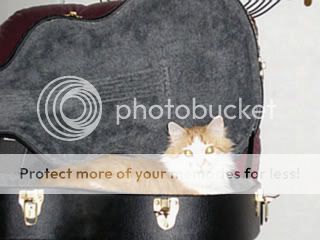A few more tips:
If you have trouble putting the cat in the carrier, set the carrier so the open side is facing up. That way, gravity is on your side when it comes to getting the cat in. A human or two plus one of the four fundamental forces of nature is almost a match for a vet-shy cat. And it’s easier to get gravity to help you put a cat in a carrier than it is to enlist, say, the strong nuclear force for this purpose.
Cats are crepuscular, which means they’re most active around sunrise and sunset (or sunrise and whenever lights-out is in your house). Take advantage of this. If you have to do something that the cat may be hard to catch for, or that the cat may object to (such as clipping its claws), try to schedule that activity for a time when your cat is less active, if possible. They’re much easier to catch then.
Flea collars are obsolete. There are new liquid anti-flea products that you put on the back of your cat’s neck about once a month that work much better. However, be sure to buy a good brand (Revolution and Advantage are good brands), and be sure to buy one that is specifically for cats. The ones made for dogs can harm your cat. If you have a strictly indoor cat, you may be able to get away without using flea-control products at all.
There are treats that can make giving pills to your cat much easier. The chicken-flavored ones are highly recommended by Luna the Treat Connoisseur. When I had to give her an antibiotic, I put the pills in these, and she begged for them.
Some cats get hairballs. The traditional remedy is a hairball gel. But there are also hairball remedy treats. Katya recommends these.
Have high places around the house where the cat is allowed to be. Cats like to be in high places that allow them to keep an eye on what’s going on around them. If the highest piece of furniture in a room is something (such as the dining room table) that you don’t want the cat on, consider buying a cat tree or tower (Petco and Petsmart have them) for that room, so the cat can be up high without being on the forbidden furniture.
A good location for a litter box is a low-traffic area of the house that is free (as much as possible) from sudden noises or other things that could scare a cat. Ideally, this area also has a hard-surface floor, no carpeting. Next to the washer and dryer isn’t a good place, since those are noisy. Next to the furnace probably isn’t optimal, either. Make sure the litter box isn’t somewhere where there will regularly be closed doors between the cat and the box. If cats don’t like the location of their litter box or are blocked from getting to it, they find their own solution.
Find a litter box and litter that your cat likes, and don’t vary them. Do not buy whatever litter is on sale this week. Stick to a brand your cat likes. Different cats like different things- some like covered litter boxes, some don’t. Scoop the litter box at least daily. There are various kinds of automatic litter boxes that can make this chore easier- I like this one and, to a lesser extent, this one. Remember, if they don’t like their litter box, they will find somewhere else to go.
Don’t vary your cat’s food. Find out what the shelter was feeding him, and start off feeding him that. If you want to switch him to a different food, start by mixing a little bit in with his familiar food, with a bit more and more of the food you want to feed him each day. Remember that your cat has the final veto on food, though. Cats, unlike dogs and children, will refuse to eat to the point of health problems if they don’t like their food. Changing a cat’s diet can also lead to vomiting and diarrhea, and they don’t head for the litter box like a human feeling vomiting or diarrhea coming on would head for the toilet.
Here’s a list of plants that are poisonous to cats. I wouldn’t have any of these indoors as houseplants or cut flowers. A lot of cats will nibble on houseplants, and mine have shown interest in flowers in vases.
Onions, garlic, and chocolate are toxic to cats. Feeding them anything too fatty can cause stomach upset or diarrhea. I avoid giving mine anything spicy, since spicy food can cause diarrhea in humans and I don’t want to deal with any more cat diarrhea than absolutely necessary.
A significant percentage of cats become lactose intolerant as they get older. If you want to give your cat milk, give him milk formulated for cats (Petco or Petsmart sell these). I wouldn’t give my cats significant amounts of any dairy product.
Cats have individual preferences for different types of toys. Get him a variety of toys at first, and once you figure out what kind of toys he likes, get that kind. I don’t buy any fragile plastic toys (the kind that would be damaged by stepping on them), because cat toys show up in unexpected places.

